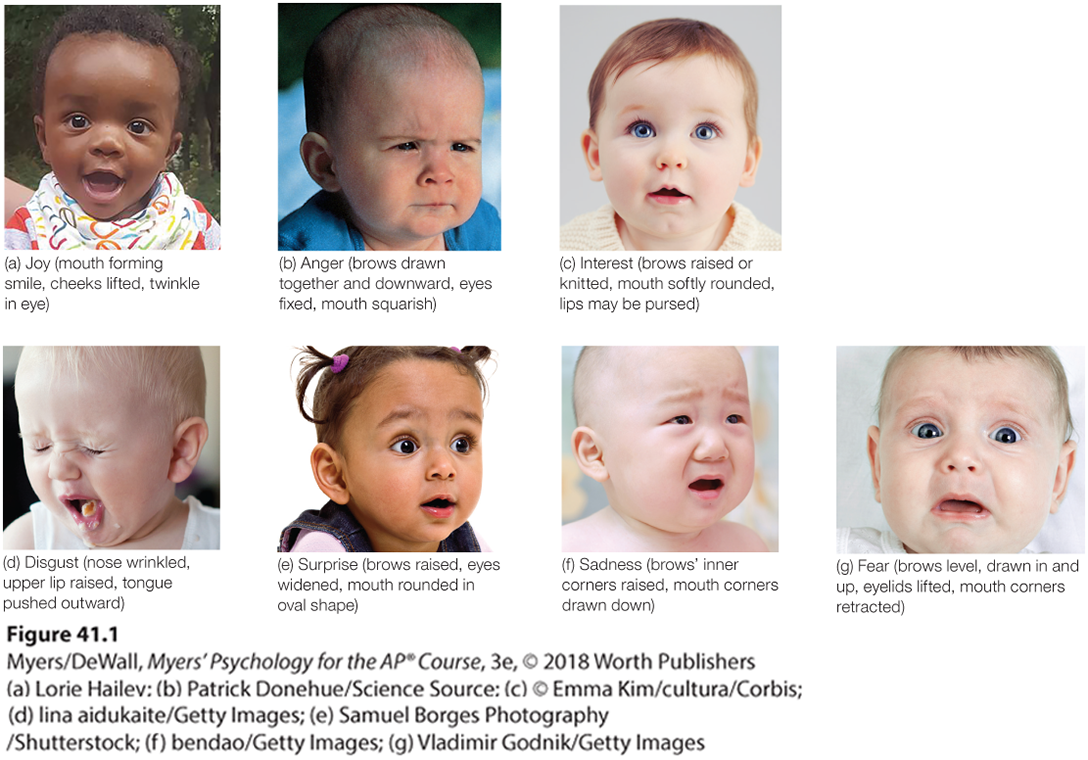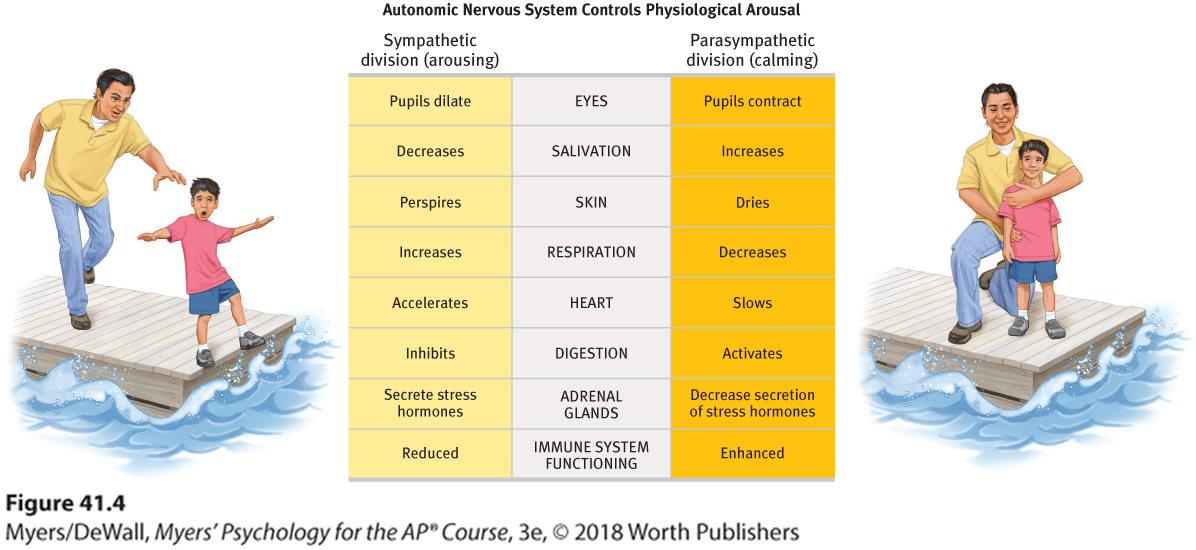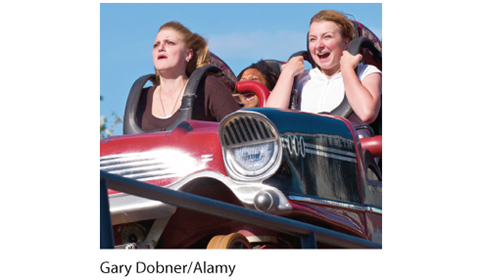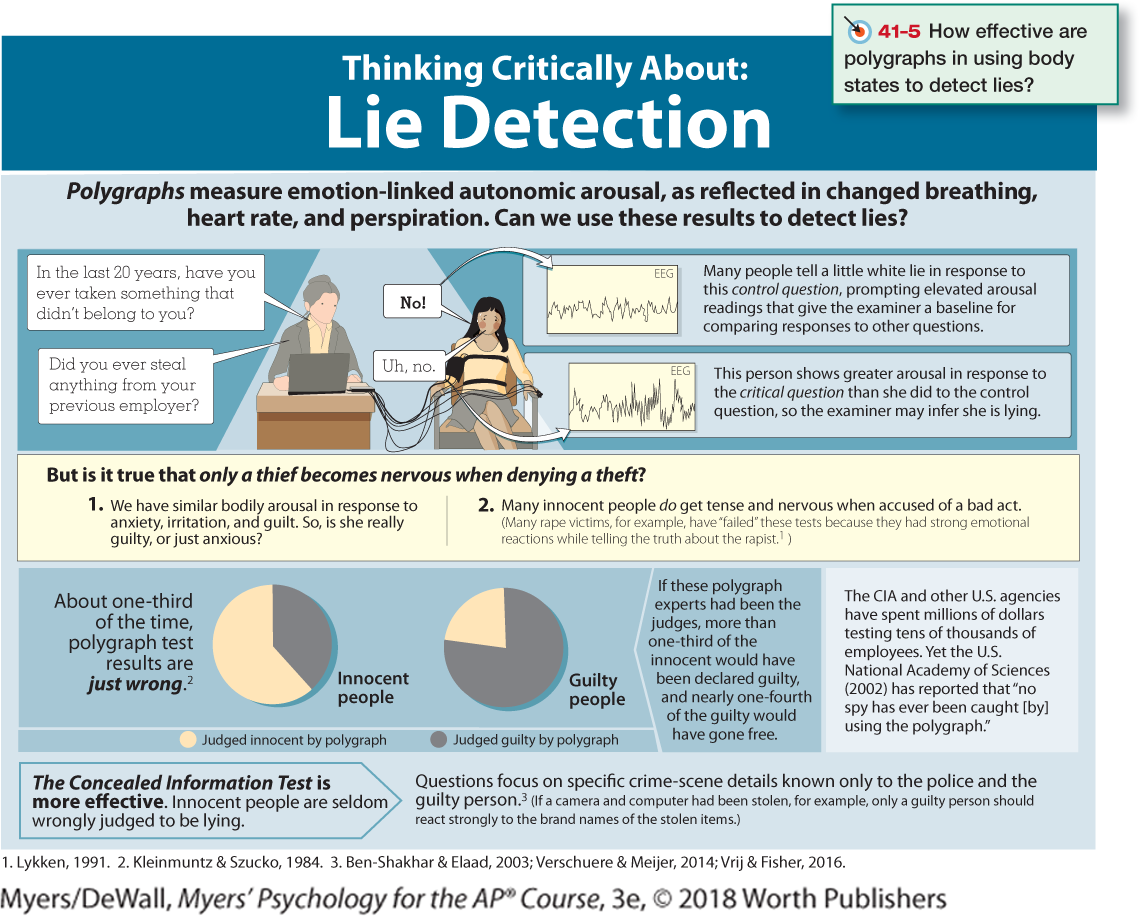Embodied Emotion
Whether you are falling in love or grieving a death, you need little convincing that emotions involve the body. Feeling without a body is like breathing without lungs. Some physical responses are easy to notice. Other emotional responses we experience without awareness.
The Basic Emotions
How many distinct emotions are there? When surveyed, most emotion scientists agreed that anger, fear, disgust, sadness, and happiness are basic human emotions (Ekman, 2016). Carroll Izard (1977) isolated 10 basic emotions (joy, interest-excitement, surprise, sadness, anger, disgust, contempt, fear, shame, and guilt), most present in infancy (Figure 41.3). Others believe that pride and love are also basic emotions (Shaver et al., 1996; Tracy & Robins, 2004). But Izard has argued that other emotions are combinations of these 10, with love, for example, being a mixture of joy and interest-excitement.

Figure 41.3 Some naturally occurring infant emotions
To identify the emotions generally present in infancy, Carroll Izard analyzed the facial expressions of infants.
Emotions and the Autonomic Nervous System
As we saw in Module 10, in a crisis the sympathetic division of your autonomic nervous system (ANS) mobilizes your body for action (Figure 41.4). It directs your adrenal glands to release the stress hormones epinephrine (adrenaline) and norepinephrine (noradrenaline). To provide energy, your liver pours extra sugar into your bloodstream. To help burn the sugar, your respiration increases to supply needed oxygen. Your heart rate and blood pressure increase. Your digestion slows, diverting blood from your internal organs to your muscles. With blood sugar driven into the large muscles, running becomes easier. Your pupils dilate, letting in more light. To cool your stirred-up body, you perspire. If wounded, your blood would clot more quickly.

Figure 41.4 Emotional arousal
Like a crisis control center, the autonomic nervous system arouses the body in a crisis and calms it when danger passes.
When the crisis passes, the parasympathetic division of your ANS gradually calms your body, as stress hormones slowly leave your bloodstream. After your next crisis, think of this: Without any conscious effort, your body’s response to danger is wonderfully coordinated and adaptive—preparing you to fight or flee. So, do the different emotions have distinct arousal fingerprints?
The Physiology of Emotions
Imagine conducting an experiment measuring the physiological responses of emotion. In each of four rooms, you have someone watch a movie: In the first, the person views a horror film; in the second, an anger-provoking film; in the third, a sexually arousing film; in the fourth, a boring film. From the control center, you monitor each person’s perspiration, pupil size, breathing, and heart rate. Could you tell who is frightened? Who is angry? Who is sexually aroused? Who is bored?
With training, you could probably pick out the bored viewer. But discerning physiological differences among fear, anger, and sexual arousal is much more difficult (Barrett, 2006). Different emotions can share common biological signatures.
A single brain region can also serve as the seat of seemingly different emotions. Consider the broad emotional portfolio of the insula, a neural center deep inside the brain. The insula is activated when we experience various negative social emotions, such as lust, pride, and disgust. In brain scans, it becomes active when people bite into some disgusting food, smell disgusting food, think about biting into a disgusting cockroach, or feel moral disgust over a sleazy business exploiting a saintly widow (Sapolsky, 2010). Similar multitasking regions are found in other brain areas.
“ No one ever told me that grief felt so much like fear. I am not afraid, but the sensation is like being afraid. The same fluttering in the stomach, the same restlessness, the yawning. I keep on swallowing.”
C. S. Lewis, A Grief Observed, 1961
Yet our varying emotions feel different to us, and they often look different to others. We may appear “paralyzed with fear” or “ready to explode.” Fear and joy prompt a similar increased heart rate, but they stimulate different facial muscles. During fear, your brow muscles tense. During joy, muscles in your cheeks and under your eyes pull into a smile (Witvliet & Vrana, 1995).
Some of our emotions also have distinct brain circuits (Panksepp, 2007). Observers watching fearful faces showed more amygdala activity than did other observers who watched angry faces (Whalen et al., 2001). Brain scans and EEG recordings show that emotions also activate different areas of the brain’s cortex. When you experience negative emotions such as disgust, your right prefrontal cortex tends to be more active than the left. Depression-prone people, and those with generally negative perspectives, have also shown more right frontal lobe activity (Harmon-Jones et al., 2002).

Scary thrills Elated excitement and panicky fear involve similar physiological arousal. That allows us to flip rapidly between the two emotions.
Positive moods tend to trigger more left frontal lobe activity. People with positive personalities—exuberant infants and alert, energized, and persistently goal-directed adults—have also shown more activity in the left frontal lobe than in the right (Davidson, 2000; Urry et al., 2004). Indeed, the more a person’s baseline frontal lobe activity tilts left—or is made to tilt left by perceptual activity—the more upbeat the person typically is (Drake & Myers, 2006).
To sum up, we can’t easily see differences in emotions from tracking heart rate, breathing, and perspiration. But facial expressions and brain activity can vary with the emotion. So, do we, like Pinocchio, give off telltale signs when we lie? For more on that question, see Thinking Critically About: Lie Detection.
